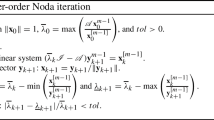Abstract
We present a Newton–Noda iteration (NNI) for computing the Perron pair of a weakly irreducible nonnegative mth-order tensor \({\mathscr {A}}\), by combining the idea of Newton’s method with the idea of the Noda iteration. The method requires the selection of a positive parameter \(\theta _k\) in the kth iteration, and produces a scalar sequence approximating the spectral radius of \(\mathscr {A}\) and a positive vector sequence approximating the Perron vector. We propose a halving procedure to determine the parameters \(\theta _k\), starting with \(\theta _k=1\) for each k, such that the scalar sequence is monotonically decreasing. Convergence of this sequence to the spectral radius of \({\mathscr {A}}\) (and convergence of the vector sequence to the Perron vector) is guaranteed for any initial positive unit vector, as long as the sequence \(\{\theta _k\}\) so chosen is bounded below by a positive constant. In this case, we always have \(\theta _k=1\) near convergence and the convergence is quadratic. Very often, the halving procedure will return \(\theta _k=1\) (i.e., no halving is actually used) for each k. If the tensor is semisymmetric, \(m\ge 4\), and \(\theta _k=1\), then the computational work in the kth iteration of NNI is roughly the same as that for one iteration of the Ng–Qi–Zhou algorithm, which is linearly convergent for the smaller class of weakly primitive tensors.



Similar content being viewed by others

References
Berman, A., Plemmons, R.J.: Nonnegative Matrices in the Mathematical Sciences. SIAM, Philadelphia, PA (1994)
Chang, K.-C., Pearson, K.J., Zhang, T.: Primitivity, the convergence of the NQZ method, and the largest eigenvalue for nonnegative tensors. SIAM J. Matrix Anal. Appl. 32, 806–819 (2011)
Chang, K.C., Pearson, K., Zhang, T.: Perron–Frobenius theorem for nonnegative tensors. Comm. Math. Sci. 6, 507–520 (2008)
Cooper, J., Dutle, A.: Spectra of uniform hypergraphs. Linear Algebra Appl. 436, 3268–3292 (2012)
Elsner, L.: Inverse iteration for calculating the spectral radius of a non-negative irreducible matrix. Linear Algebra Appl. 15, 235–242 (1976)
Friedland, S., Gaubert, S., Han, L.: Perron–Frobenius theorem for nonnegative multilinear forms and extensions. Linear Algebra Appl. 438, 738–749 (2013)
Grassmann, W.K., Taksar, M.J., Heyman, D.P.: Regenerative analysis and steady-state distributions for Markov chains. Oper. Res. 33, 1107–1116 (1985)
Hu, S., Huang, Z.-H., Qi, L.: Finding the spectral radius of a nonnegative tensor. arXiv:1111.2138v1 (2011)
Hu, S., Qi, L.: The Laplacian of a uniform hypergraph. J. Comb. Optim. 29, 331–366 (2015)
Hu, S., Qi, L., Xie, J.: The largest Laplacian and signless Laplacian \(H\)-eigenvalues of a uniform hypergraph. Linear Algebra Appl. 469, 1–27 (2015)
Jia, Z., Lin, W.-W., Liu, C.-S.: A positivity preserving inexact Noda iteration for computing the smallest eigenpair of a large irreducible \(M\)-matrix. Numer. Math. 130, 645–679 (2015)
Kelley, C.T.: Iterative Methods for Linear and Nonlinear Equations. SIAM, Philadelphia, PA (1995)
Kolda, T.G., Bader, B.W.: Tensor decompositions and applications. SIAM Rev. 51, 455–500 (2009)
Liu, C.-S., Guo, C.-H., Lin, W.-W.: A positivity preserving inverse iteration for finding the Perron pair of an irreducible nonnegative third order tensor. SIAM J. Matrix Anal. Appl. 37, 911–932 (2016)
Liu, Y., Zhou, G., Ibrahim, N.F.: An always convergent algorithm for the largest eigenvalue of an irreducible nonnegative tensor. J. Comput. Appl. Math. 235, 286–292 (2010)
Ni, Q., Qi, L.: A quadratically convergent algorithm for finding the largest eigenvalue of a nonnegative homogeneous polynomial map. J. Global Optim. 61, 627–641 (2015)
Ng, M., Qi, L., Zhou, G.: Finding the largest eigenvalue of a nonnegative tensor. SIAM J. Matrix Anal. Appl. 31, 1090–1099 (2009)
Noda, T.: Note on the computation of the maximal eigenvalue of a non-negative irreducible matrix. Numer. Math. 17, 382–386 (1971)
Pearson, K.J.: Essentially positive tensors. Int. J. Algebra 4, 421–427 (2010)
Raftery, A.E.: A model of high-order Markov chains. J. R. Stat. Soc. Ser. B 47, 528–539 (1985)
Varga, R.S.: Matrix Iterative Analysis. Springer, Berlin (2000)
Yang, Y., Yang, Q.: On some properties of nonnegative weakly irreducible tensors. arXiv:1111.0713v2 (2011)
Yang, Y., Yang, Q.: Further results for Perron–Frobenius Theorem for nonnegative tensors. SIAM. J. Matrix Anal. Appl. 31, 2517–2530 (2010)
Zhang, L., Qi, L.: Linear convergence of an algorithm for computing the largest eigenvalue of a nonnegative tensor. Numer. Linear Algebra Appl. 19, 830–841 (2012)
Zhang, L., Qi, L., Zhou, G.: \(M\)-tensors and some applications. SIAM J. Matrix Anal. Appl. 35, 437–452 (2014)
Author information
Authors and Affiliations
Corresponding author
Additional information
C.-S. Liu was supported in part by the Ministry of Science and Technology in Taiwan, C.-H. Guo was supported in part by an NSERC Discovery Grant and ST Yau Center at Chiao-Da in Taiwan, and W.-W. Lin was supported in part by the Ministry of Science and Technology, the National Center for Theoretical Sciences, and ST Yau Center at Chiao-Da in Taiwan.
Rights and permissions
About this article
Cite this article
Liu, CS., Guo, CH. & Lin, WW. Newton–Noda iteration for finding the Perron pair of a weakly irreducible nonnegative tensor. Numer. Math. 137, 63–90 (2017). https://doi.org/10.1007/s00211-017-0869-7
Received:
Revised:
Published:
Issue Date:
DOI: https://doi.org/10.1007/s00211-017-0869-7



